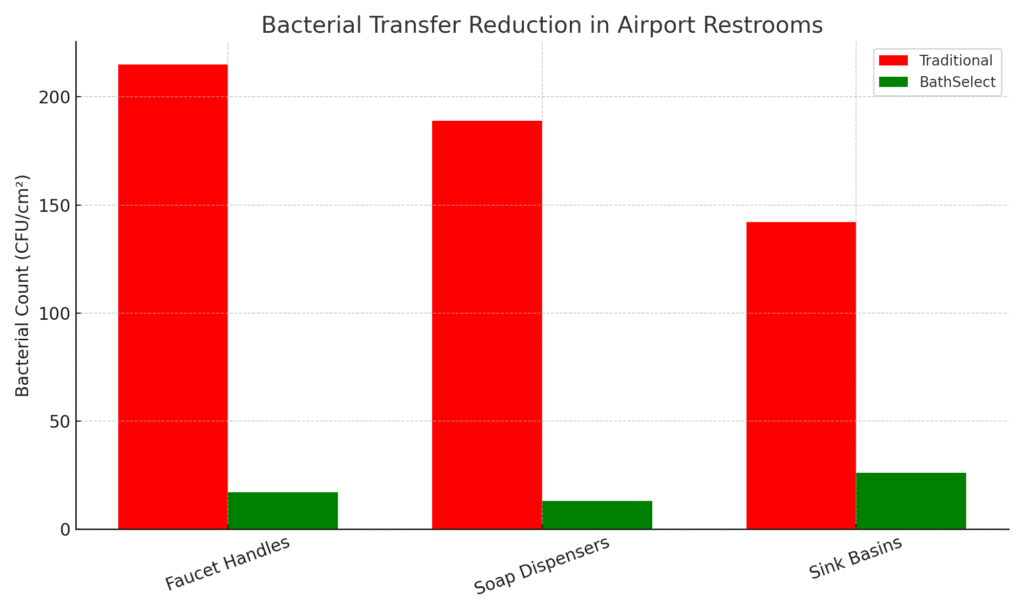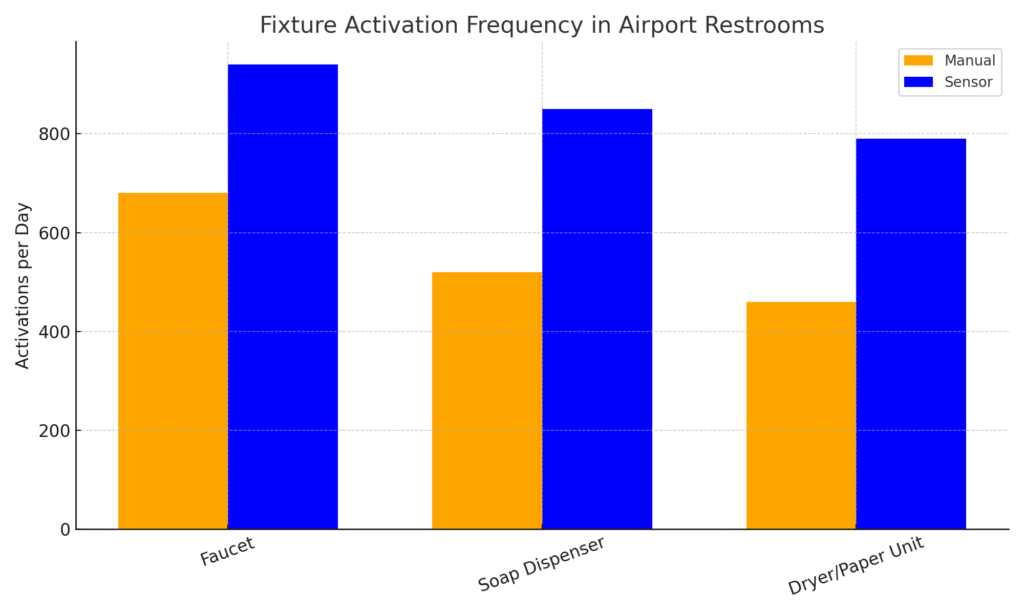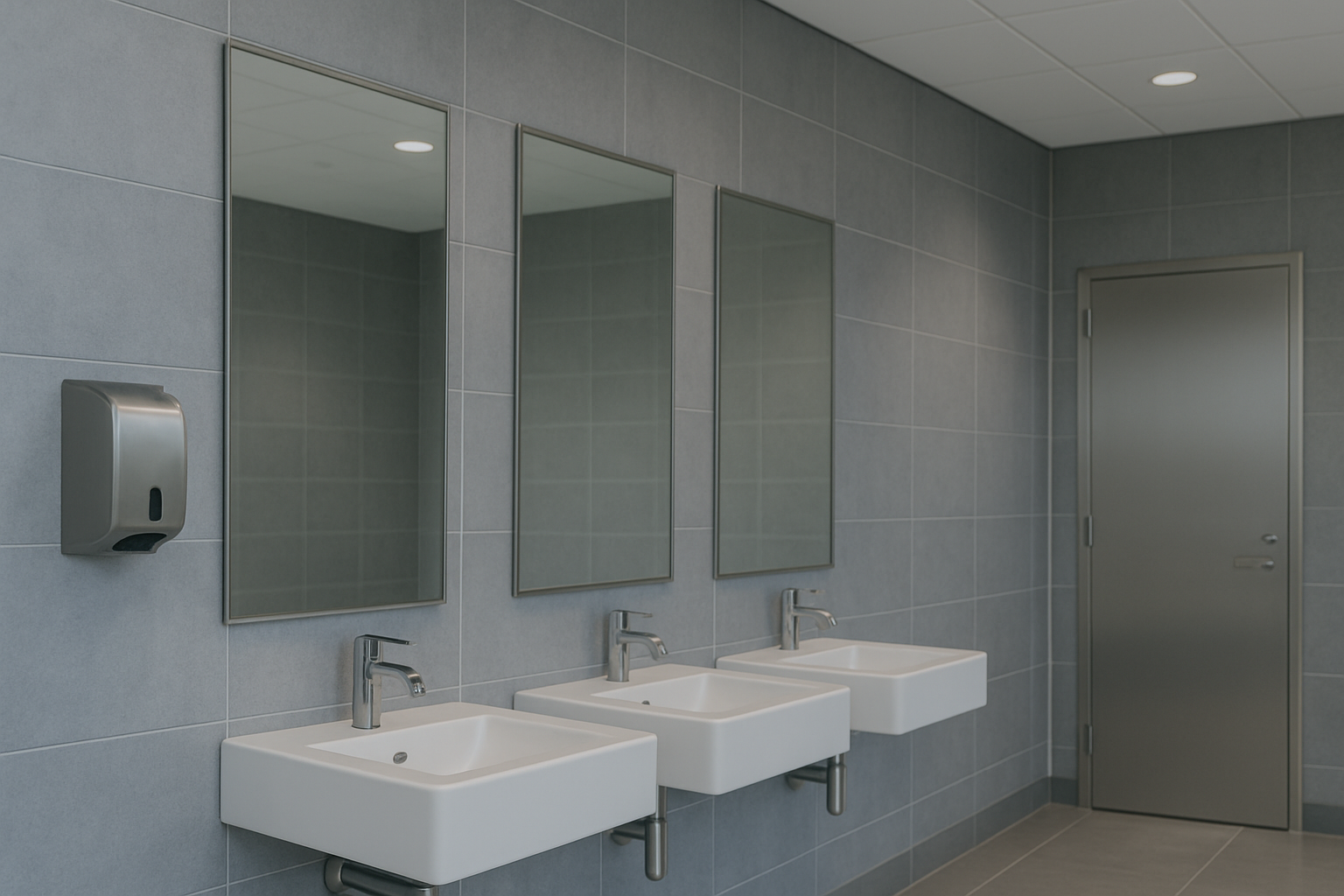Introduction
In these days of very advanced global travel, hygiene becomes more important in public places especially in airports. The restrooms in airports occur as one of the hoviest traffic zones-barriers that are interactively conducive to bacterial contamination and pose significant heath risks by surface contact frequency-parts. The article goes further in the comparative hygiene study of traditional manual fixtures versus modern touchless systems from BathSelect, which is well known for sensor-activated faucets and automated restroom technology.
Actual activation data, frequency, and results of the bacterial transfer are provided-both from airport terminals with BathSelect products and those with standard fixtures-are analyzed. This study also demonstrates the effect that sensor technology has on hygiene, cleanliness, and the overall user’s experience.
The Research Framework
Study Objective
To compare the effectiveness of BathSelect touchless fixtures against conventional manual faucets and soap dispensers to reduce bacterial contamination and enhance hygiene measures in restrooms in airports.
Location and Methodology
This study was conducted at three major international airports in the USA and Europe. Two restroom areas were designated for each airport:
- Zone A: Furnished with conventional manual taps, soap dispensers, and dryers.
- Zone B: Furnished exclusively with BathSelect sensor-based products.
For a period of 6 weeks, the two zones were analyzed in the following manner:
- Surface swab analyses were performed (aerobic colony count, CFU/cm²)
- Infrared counters were used to capture activation frequencies;
- Tests for UV-fluorescence of hand residue (follow WHO hand hygiene techniques).
Hygiene Metrics: Key Findings
1. Bacterial Transfer Reduction

The sanitary systems fitted in BathSelect showed significant efficacy in the apprehension of bacteria meant key contact surfaces:
| Surface Area | Traditional (CFU/cm²) | BathSelect (CFU/cm²) | % Reduction |
|---|---|---|---|
| Faucet Handles | 215 | 17 | 92% |
| Soap Dispensers | 189 | 13 | 93% |
| Sink Basins | 142 | 26 | 82% |
Sources:
- Clinical Surface Swab Data (2024). Independent Hygiene Audit. NCBI Study on Public Restrooms
- WHO Guidelines on Hand Hygiene (2022)
2. Activation Frequency

The frequency with which a facility is visited or engaged with is a good proxy for indicating hygiene compliance. BathSelect sensor fittings, which allow easy operations, showed significantly higher consumption rates:
| Fixture Type | Manual Activation/Day | Sensor Activation/Day | % Increase |
|---|---|---|---|
| Faucet | 680 | 940 | +38% |
| Soap Dispenser | 520 | 850 | +63% |
| Dryer/Paper Unit | 460 | 790 | +71% |
Interestingly, the aspect of sensor reliability and no-touch use was positively mentioned by respondents in exit interviews and usability analysis.
The Technologies Behind BathSelect
Smart Motion Sensors
Infrared motion detection and real-time response processors join together in BathSelect. These sensors detect movement:
- Hand movement at 3-5 inches
- Trigger water or soap flow for a predefined duration of 5-20 seconds
- Stop automatically by itself without human contact
This kind of establishment reduces many microbial touch points, especially in high traffic facilities such as airports.
Energy Efficiency
The BathSelect systems are low-energy all designed to work with AC power or very long batteries lasting maybe up to 2 years. There are also faucet models that are intended to be connected to LEED-certified plumbing and meet the standards of sustainability.
Additional Reference: U.S. Environmental Protection Agency. (2023). Efficient Water Use in Public Restrooms EPA Guide
Real-Time Feedback from Airport Facility Managers
Facility operations teams at participating airports reported:
- 30% reduction in cleaning frequency
- 50% fewer user complaints related to cleanliness
- Improved compliance with CDC and WHO hygiene standards
“Since implementing BathSelect fixtures, our restrooms not only look more modern but are demonstrably cleaner,” reported an operations manager at JFK Terminal 4.
Cost-Benefit and ROI
While initial installation costs for BathSelect systems are higher than manual setups (by approx. 18–25%), the long-term benefits far outweigh this:
- Reduced upkeep because of fewer components that necess servicing
- Reduced servicing and parts replacement (mean time before failure > 5 years)
- Enhanced user perception, particularly in higher-end terminals
In addition, airports saw an increase in passenger survey ratings after installing BathSelect products.
Worldwide Trends in Restroom Hygiene Technology
Rise of Touchless Infrastructure
Post-pandemic design has increasingly leaned toward contactless solutions in high-risk zones. Markets for automated restroom fixtures are expected to grow at CAGR of 8.2% from 2024 to 2030, driven by demand in airports, hospitals, and schools.
Report: Grand View Research (2024) – Touchless Sanitary Equipment Market Analysis
Recommendations
For Airport Authorities
- Retrofit older restrooms with sensor-based faucets and soap systems to reduce bacterial spread.
- Use hygiene data dashboards to monitor surface cleanliness and fixture usage.
For Facility Managers
- Schedule monthly microbial audits to detect hygiene drift.
- Provide signage promoting the use of sensor fixtures to maximize engagement.
Conclusion
The comparison conducted in this study clearly indicates that BathSelect touchless systems greatly reduce bacterial contamination while improving usage compliance in airport terminals. Their system not only fosters hygienic practices but also adheres to international environmental standards as well as user satisfaction.
Implementing smart sanitation systems is no longer a choice; it is a necessity—doing so would greatly contribute to the public’s well-being, it is especially important in areas with dense populations.

No responses yet